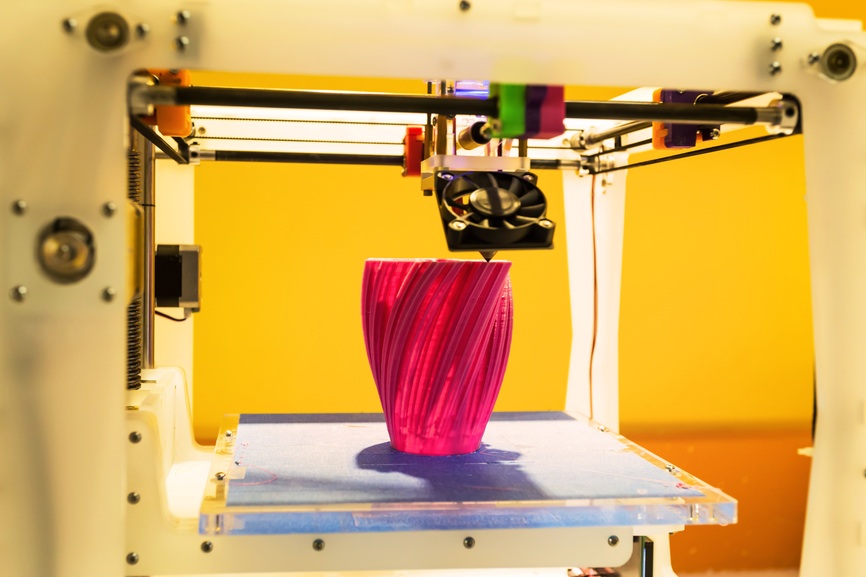February 5, 2015 – Today’s guest blogger is Paul Reyes-Fournier. Paul has served as chief financial officer for a number of organizations including social services, churches and schools. He founded his own marketing firm, RF Media and holds a Bachelor of Sciences degree in physics as well as an MBA. I hope you enjoy reading Paul’s contribution to 21st Century Tech blog.
———-
It is now thirty-five years since the first patent applications for 3D printing were filed in 1980. Like so many technologies it has taken a bit of time for this technology to go mainstream. In fact, it was not until 2000 that the first commercial 3D printers were introduced. By 2007, personal-use 3D printers had gone from fad to disruptive innovators creating a new market for design and manufacturing. Arguably, we are just beginning to see how 3D printing technology will launch a new era in engineering, distribution and human productivity.
By its other name, additive manufacturing, 3D printing today is largely limited by the materials the printer uses in creating its end products. When first commercialized, 3D printers used specialized plastics to build models. These had limited use and hence 3D printing seemed stuck in the hobbyist market and not a tool for serious engineering. But this is changing as new materials get added to 3D printing’s repertoire. Today 3D printers can use metals, stem cells and many plastics as source material.
Rubber sealant manufacturer, Apple Rubber, is looking to the day when 3D printers can produce a finished product at a cost per unit equivalent to today’s best industrial processes. But for this to happen Apple needs the technology to not only mass produce items quickly but withstand heat in excess of 177 Celsius (350 Fahrenheit) degrees and pressures over 68,947,570 pascals (10,000 pounds per square inch to meet product tolerance requirements. As one of the largest companies in the business of designing and manufacturing o-rings, medical seals and many other sealing products, the company sees 3D printing as a better fit for creating one-off molds for design prototypes. Andrew Rich, an Apple product engineer states, “this would speed up the lead time by allowing us to make molds quicker.”
Futurists use the term disruptive to describe 3D printing because it has potential to radically alter the way we can speed up the front end of product development. Going from an idea to prototype can be almost instantaneous with low-cost printers that almost any business can afford. Check out, for example, The Micro, a 3D printer that on Kickstarter cost $349 US. It is products like this that are making 3D financially attainable for personal use. For idea-smiths they no longer need to deal with the time delays and start-up costs associated with creating a prototype. Instead, they can go from thought to reality without leaving the office, basement, or garage.
And 3D manufacturing provides a capability that no previous manufacturing process can duplicate. A part designed on one side of the world can be printed on a 3D printer at the recipient’s location. This is something the U.S. Postal Service is exploring. Instead of manufacturing a part and shipping it across the nation, one possible solution would have the post office or other delivery service act as a middleman receiving 3D specifications from individuals and printing the items locally, and then delivering them at low cost. A recent report by Christensen Associates on behalf of the Post Office estimates, “that 3D printing could raise the Postal Service’s annual package revenue by $485 million as businesses ship increasing numbers of 3D printed goods to consumers.” As additive manufacturing technology becomes more cost competitive, this idea could be extended to large volume items or even one-off multi-part assemblies.
So today 3D printing is following a similar path to many other digital technologies such as cellular telephones, and digital cameras. At first the technologies are niche market products and expensive. But as they become commonplace and affordable they explode into the market.
Science fiction writers and futurists see a near-future world with 3D printers in every home capable of creating almost anything the home needs from a plastic cup to a new toy to a replacement part for household equipment. The designs for these will be in the cloud, some free, others at very affordable prices, all downloadable from the Internet.
But wait, 3D printing is evolving to the 4th dimension. Aptly named 4D by Stratasys and its conceiver, Skylar Tibbits, an MIT graduate, this form of printing uses shape memory materials and electroactive polymers to create objects that morph over time. In 2013 the world saw its first 4D printer. How long will it be before we see transformative, shape-shifting, multi-purpose products being produced in business and homes? If the evolution of 3D printing is an indicator, not that far into the future.
















